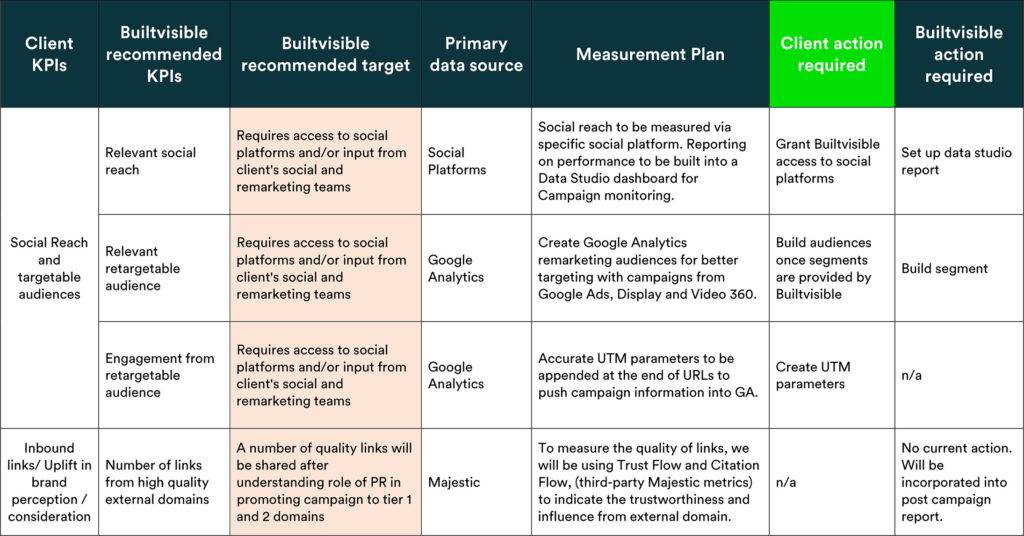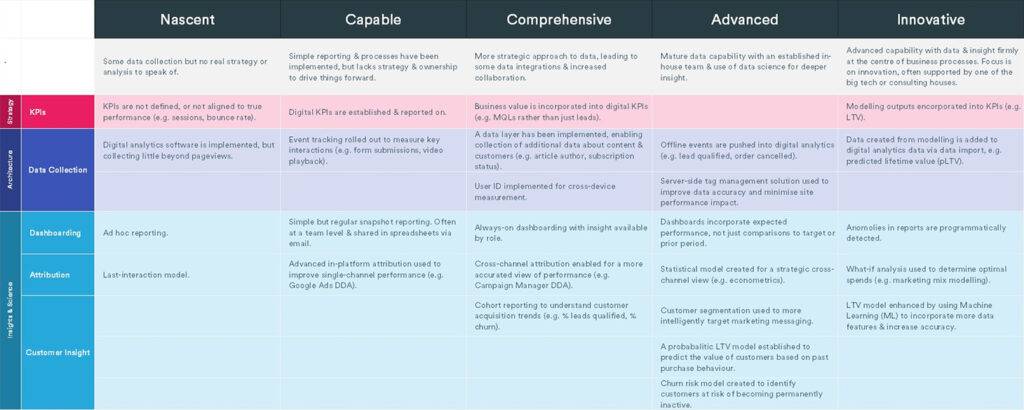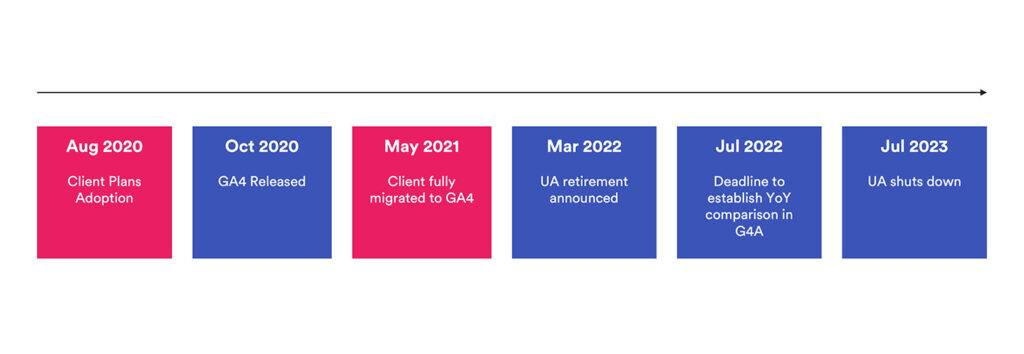Importance of first-party data
Despite there being a wealth of SEO tools, which use second- and third-party data to pull forward a clear, insightful picture of the SEO landscape, your competitor landscape, keywords, and so forth, they can’t see what users are doing on your website. They can’t ultimately see the bottom line of your business and the impact you have on it. Our Opportunity Sizing is a notable example of this kind of approach where we take a blend of first- and second-party data to make sure we’re focusing in the right areas and making sure we’re achieving tangible results for your business.
The ripple effect
Moreover, good SEO doesn’t happen in a vacuum. It’s clear that other people have an impact upon your SEO work. What’s often overlooked is the impact that goes the other way. These days Google’s ranking factors are primarily focused on UX-based improvements, which could be felt across your entire digital ecosystem. Looking at SEO in isolation may completely overlook the impact the team has elsewhere.
Likewise, when you improve things like page speed, it should lead to a rankings improvement and that is the target you set for yourself. However, it could also lead to knock-on effects on other channels, prompting lower CPCs within paid search because of an ad rank improvement. On the on-page optimisation side, you are aiming for higher click through rates, which could eventually lead to better conversion rates on the website because people are better sign posted to where they want to go, what this content is and hopefully a better and more performant website.
First-party data is too often overlooked
A common disapproval amongst clients about the use of first-party data, particularly in the SEO space, is they don’t believe it to be accurate; they don’t look at it and they don’t trust it. A lack of trust is a massive problem to a team who are trying to be data-driven. An alternative route is making sure that your data is well documented and the internal knowledge is shared across your organisation. It’s not exciting, but it’s really important to make sure you’re setting a good data foundation that you can build upon.
Good data doesn’t occur organically
Popping a tool like Google Analytics on your website and having it collect some data for you is simply not enough. It’s vital to understand its purpose along with the data it’s going to collect, and, more importantly, what you can additionally bring to it. With Google Analytics 4 and Enhanced Measurement, there’s plenty of out of the box tracking that can now take place, but these are things common across all websites, such as scrolling, form submissions, or clicking on outbound links. It’s not going to provide you with any context around your business. By having thorough custom event tracking, and a really clear plan on what that means to your business, you could really level things up.
So, whether you’re starting from scratch or levelling up, all you must know is if you are on your journey, what the next step is, and what the destination looks like. To do this, you’ll need a clear and actionable plan to hold everyone accountable for making progress. This may not be terribly exciting, but a lack of a plan is the most common reason for failure – and the biggest blocker to truly exciting insights.
The ultimate benefit of establishing these measurement plans is to ensure your campaigns launch on time and smoothly. In a recent campaign for our client, agreeing on KPIs upfront, minimised any confusions around how we’d measure success and disagreements on results when they were reported back.

Assess your capabilities, not just your data
But don’t forget, the data isn’t itself the destination. Take a look at your roadmap – if there’s a lot of data collection but no analysis or activation, then you’re not unlocking the value for your business. Making sure you are continually putting the data to work. That is key to getting buy-in and navigating uncertain times.
Correspondingly, we created a data science solution ‘SEOcausal’ for our client to go a step beyond the solid data foundations they already had in place. The causal analysis model, which takes a time series of first-party or any third-party data, helped us forecast performance in the post-optimisation period. Through a comparison to the actual results, we could tell you with 95% confidence that the 6% increase in the client’s organic traffic was due to on-page optimisations we implemented. It offered a clear and compelling case. This further helped the team get a much better buy-in across the business and really helped to improve priority for development requests that they were making
The data maturity curve
So, to create a robust data strategy, the key is a structured approach in getting to your destination. Although tempting to skip ahead, it only increases the complexity of every step and hence the likelihood of failure. At Builtvisible we use the concept of data maturity.

Descriptive analytics – At first, we have descriptive analytics, where we simply just describe what is going on. So as an example, we would tell you organic traffic had gone down 10% month on month.
Diagnostics – The next stage is to look at diagnostics. This starts to explain why that’s happened. If organic traffic is going down 10% month on month, but we see a new PPC campaign that’s gone live, we start to identify there’s some cannibalisation that’s going on.
Predictive analytics – Once we know what’s going on and why it’s happening, we are able to lay out expectations of the future based on these rules. It would explain the newfound dynamic between organic and PPC and give us direction on how we plan to spend on PPC over the next three months. This will start to give us that visibility going forward.
Prescriptive analytics – Here, since we are aware of what happens next and the goals we want to achieve, we then determine how far away we are from our set targets. This way we can lay out plans to move the needle for the above two to be aligned.
The road to success isn’t linear
Data Maturity isn’t a linear process; it’s a curve where we realise a little bit more value at each stage. So for each step we take, it also gets exponentially harder to do this, we need additional tooling and we need additional skills. The time to explain these efforts to senior stakeholders and really get their understanding and their buy-in is also more. As a result, we must take a structured approach without skipping a step.
The way we structure this strategy is through our Data Maturity Framework. It is a template for client success; it isn’t comprehensive, no framework can be. Nonetheless, it provides us with a clear jumping off point to understand our existing position and the next logical steps, which could eventually lead to conversations. There could be some challenges around things we would need to understand better, but it allows us to understand what we know, don’t know and our focus going forward in the future.
The Builtvisible Data Maturity Framework
The framework is structured into five categories, starting with Nascent. We don’t do much here. We merely implement the core Google Analytics tag and carry out minimal ad hoc reporting. Capable is going a step further and saying we do a little more than this. We collect some custom data and we have a basic plan.
Comprehensive starts to bring strategy into the fore. There’s a clear owner, strategy and part of a roadmap. We look slightly beyond value and volume. We’re starting to truly look at profitability, longer term returns, qualified leads rather than purely leads generated. We also begin bringing in user ID to stitch users together across different sessions, devices and channels. This allows us to do more complex attribution and undoubtedly open up the realm of machine learning.
Advanced is about moving towards machine learning capability to dive deeper into that right-hand side of the maturity curve that we have seen above. It delves into the realm of the unknown and innovation opportunities arising from it.

Build a roadmap to advance in key areas of weakness or opportunity
Now, it’s about building the roadmap, which is extremely important. It’s often overlooked, but it is crucial. It provides you with tangible insights to immediately share with all of your stakeholders to get their buy-in. How? Well, by easily identifying the benefits you could avail at each stage. So at the beginning of the year, you start with a particular task, identify its benefit and clearly state it within your roadmap. The same process repeats with following tasks all the way through that year.
When building a roadmap for a client, we were able to evidently determine the areas we needed to focus on in the immediate term using our framework. Although the client was mostly towards the end of the Comprehensive stage with a goal to cross-over into Advanced, they certainly had some incomplete areas. A breakdown on the key areas of focus helped us distinguish aspects needed to complete the Comprehensive section from those required to move us within the Advanced stage. Once at the final stage, we would shift our attention in the roadmap template towards what we expect to be happening, rather than simply what is happening.
Embracing technological change for strategic advantage
The intent to move ahead led to one very simple project; the adoption of Google Analytics 4 (GA4). Even in its earlier beta version, called app and web properties, it solved numerous problems that we were trying to unlock. So in addition to the areas of focus discussed above, the client faced some limitations around data collection. The problem was resolvable using the app and web beta, now GA4, due its considerably flexible and scalable nature.
Lack of data restrictions made it much easier to access data without sampling frustrations and ensured accurate reporting across a larger date-range. GA4 further came with built-in capabilities when launched later in the year. These became especially helpful in the move towards the modelling side. Now, lifetime value modelling didn’t require us to get our data scientists involved immediately to understand the next advanced stage. Cohort reporting, similarly, was built into the platform. These features granted us a clear view of how people were engaging with the business over time and whether they were likely to stop trading with us. Last but not least, it brought with it built-in anomaly detection. This enabled us to immediately see irregularities in our data upon creating reports in the new Explorer interface within GA4.
Keeping this in mind, we begin talks of GA4 with our client in August 2020. We got our client fully migrated in May 2021, following its official public launch in October 2020. We weren’t necessarily talking to many clients about GA4 at all around this time. Upon the release of Universal Analytics’ retirement dates from March, 2022, GA4 undeniably kicked off in earnest. It was with the goal to preserve year on year data ahead of the July, 2023 shutdown. This led to the client being massively ahead of the curve, which was all thanks to having an extremely clear plan built on a strategic framework.

Some final golden rules of a successful data strategy
To summarise, what we want you to take away from the post is simply a handful of golden rules that will help you create a successful data strategy and navigate the most turbulent of waters.
- Use first-party data towards making sure that you have the impact you want by identifying the right opportunities and getting your fair share of credit.
- Establish a strategic plan and take ownership of that plan to guarantee you can use first-party data as well as possible.
- Ensure the plan is realistic, when considering long-term planning, so you are able to better break it down into multiple steps of marginal gains.
- Build across the roadmap and make sure you’re stepping up in a structured way.
- Finally, see it through.
Still not quite sure where to start? Get in touch if you need a hand in establishing a robust data strategy from scratch or if you simply have a burning question we’ve missed.
